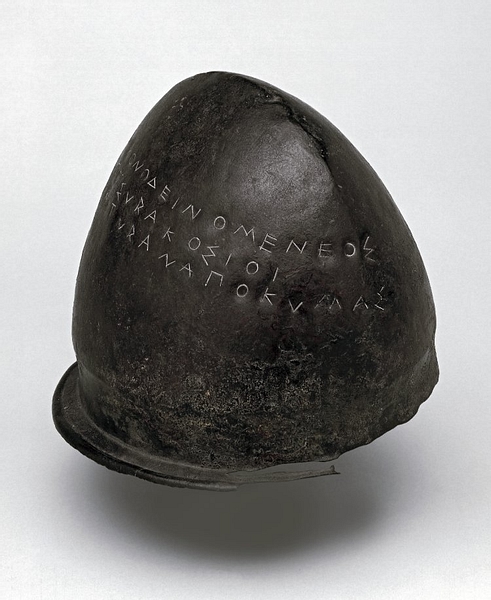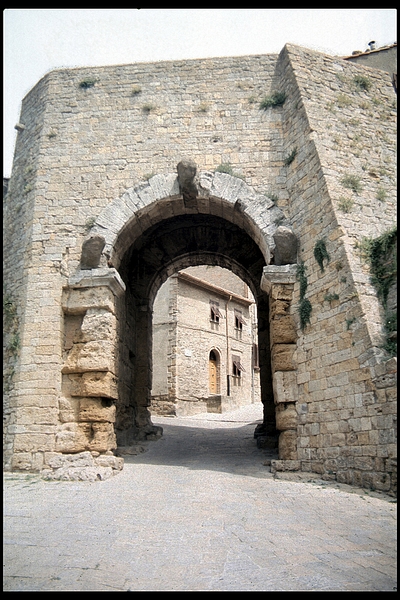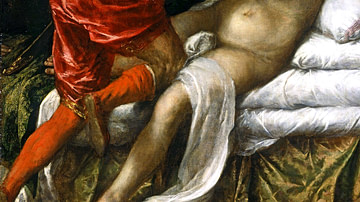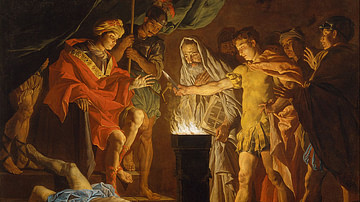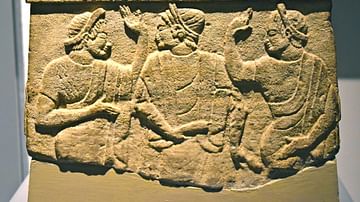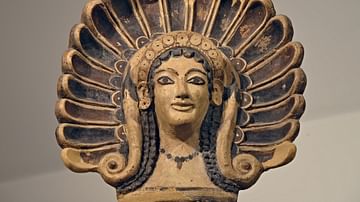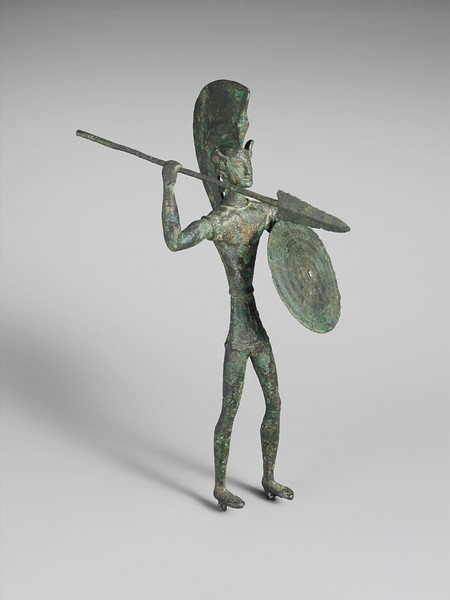
The Etruscan civilization, which flourished in central Italy from the 8th to 3rd century BCE, gained a reputation in antiquity for being party-loving pushovers when it came to warfare, but the reality is somewhat different. History being most often written by the victors, the Etruscans were conquered by and assimilated into the Romans' fast-growing empire, and Latin authors minimised the debt they owed to Italy's first great civilization and the difficulties they had in establishing themselves as top dog in the region. Without extensive written texts of their own, the history of the Etruscans must be pieced together from what little remains of their culture, namely, the ruins of fortification walls, surviving weapons, armour, and artworks depicting warfare-related themes, and secondhand accounts of ancient writers. Nevertheless, some features of Etruscan warfare become clear: the use of bronze armour, shields and swords, a preoccupation for defence shown in the building of fortification walls, and a general lack of unity between cities, which would, in the end, ring the death knell of the Etruscan culture.
Weapons & Armour
Etruscan armies, like most Mediterranean fighting powers of the day, were drawn from the citizen body who were otherwise farmers when not at war. Soldiers paid for their own equipment and fought for their individual city-state to protect its and their own interests either to defend their territory or expand it, for control of trade routes on land and sea, and to acquire the resources they deemed necessary. From the 5th century BCE, evidence of paid soldiers and mercenaries is seen in the minting of coinage for that purpose.
Armour was of bronze and took the form of breastplates, greaves to protect the lower legs, helmet, and round shield, much like the hoplite of Greek warfare. It is likely that hardened leather was widely used as body armour too. Lighter and more effective than bronze, such perishable material would not have survived as bronze armour has done. The principal weapons were bronze spears and double-edged swords. A stele from Vetulonia depicts an Etruscan warrior carrying a double-axe, but this may have been a symbol of authority rather than a weapon. Both bronze armour and weapons of the Greek hoplite type have been found in multiple Etruscan tombs of the 8th and 7th century BCE at sites such as Cerveteri, Tarquinia, Veii, and Vetulonia. However, it is important to note here that some of these weapons, and helmets in particular, may have only had a symbolic ritual purpose and may not have actually been used in battle. An example is the famous bronze helmet of Veii with its huge and impractical bronze triangular crest. Corinthian helmets have also been found in tombs, but the most common type is the plain bell-shape in bronze which has a narrow brim and, in some cases, detachable cheek-guards.
Another less than clear issue is the Etruscan use of horses in warfare. Tombs abound with bronze horse bits, and there are numerous bronze two-wheeled chariots interred with the dead. Just whether these were used in warfare or if they were merely a symbol of wealth or whether they were intended only to aid the deceased in their passage into the next life is a moot question.
Organisation & Tactics
As the historian N. Spivey makes clear, reconstructing the Etruscan military past has its difficulties:
The literary evidence is untrustworthy, and the iconographical evidence is to be treated with caution. Constructing Etruscan realities from depictions of warriors on either imported Greek and near-eastern artefacts is dangerous. (127)
Roman writers and Etruscan art demonstrate that Etruscan warriors, armed as they were like the hoplites of Greece, may also have adopted the Greek phalanx formation – a line of warriors moving forward as one on the battlefield with spears bristling and protecting each other with a solid barrier of bronze shields. Hoplite warfare was brief and brutal with the two sides clashing but had the advantage that the issue was often settled in one encounter.
However, such tactics as the phalanx may only have been used early on in Etruscan history when battles were between rival cities to settle disputes in a formulaic set-piece battle. The fact that most Etruscan helmets are of a simpler bronze bowl type would suggest that warfare was typically more dynamic, and greater visibility and mobility required that type of helmet. The greater protection but more restricted visibility of the Corinthian helmet is better suited to more static phalanx engagements, but they are in a minority when it comes to archaeological finds. Similarly, shields are generally smaller in the 5th century BCE as compared to the 6th century BCE.
Fortifications & Siege Warfare
Many Etruscan cities were protected by city walls. Not always entirely enclosing a city, they protected it from attack at its weakest points. Those sections not benefitting from a wall were usually protected by a natural precipice or man-made terraces and ditches. Portions of fortification walls survive at Cerveteri, Tarquinia, Veii, Vulci, and other cities. Made from either mud-bricks on top of stone plinths or entirely from tufa blocks, most date from the 5th century BCE. Many include well-built gates with their own towers. Such fortifications were designed to offer the community – both town and country dwellers – a temporary point of refuge in the case of attack. However, that walls could stand a prolonged attack is evidenced by the 10-year Roman siege of Veii between 406 and 396 BCE.
Naval Warfare
If the history of Etruscan land warfare is rather patchy, then their naval exploits are positively threadbare in the historical record. With a plentiful supply of timber, the Etruscans were able to build large sailing ships which, under the power of oars in battle, could ram enemy ships to be then boarded by their compliment of foot soldiers if necessary. The importance to the Etruscan economy of maritime trade is attested by the depiction of ships in art, the presence of model ships in tombs, and the prodigious amount of foreign goods that found their way to Etruria.
That the Etruscans were able sailors and navigators is attested by Greek and Roman writers, even if only by the rather backhanded compliment of continuously referring to them collectively as Tyrrhenian pirates, such was their domination of the waters off the coast of western Italy. This 'piracy' was more likely legitimate trade operations which the Greeks and Romans would dearly have loved for themselves. The legendary prowess of Etruscan seamen is further illustrated in the Greek myth that even the god Dionysos found himself captured by them and only managed to escape by changing the sailors into dolphins. Greek writers mention that the Etruscans managed to occupy parts of Sicily, Sardinia, Corsica, Samos, and southern France and Spain, even rivalling the great naval power of Carthage in the Mediterranean. The good times at sea came to an end, though, with the rise of Syracuse and defeat at the Battle of Cumae in 474 BCE.
Roman Conquest
The Etruscan armies of part-time soldiers, probably recruited on a basis of kinship or clan membership, proved to be no match for the more professional and tactically dynamic Roman army which was able to draw on greater resources of both men and equipment. Another disadvantage of the Etruscan cities was their failure to support each other against the common threat of Rome. Individual cities had in the past formed alliances to good effect, as seen in the defeat of a Phocaean fleet by a joint Cerveterian and Carthaginian force in 540 BCE, but the military weakness of the Etruscans was all too evident in the wave of attacks from Syracuse in the first quarter of the 4th century BCE when Etruscan coastal sites were sacked and their lucrative trade routes taken over by the Sicilians.
Etruria, or more correctly, the northern parts of Italy the Etruscans had colonised, was also attacked from the north by migrating Celts starting from the beginning of the 5th century BCE, a conflict which culminated in defeat at the Battle of Melpum (Milan) in 396 BCE. After six centuries, the Etruscan control of central Italy was suddenly under serious threat from two directions.
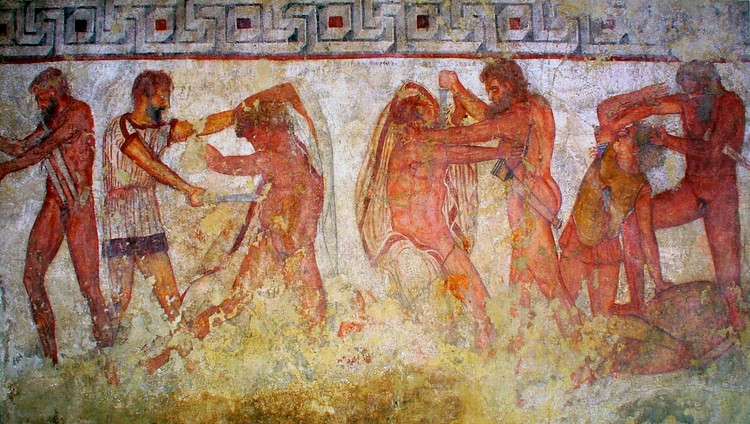
The Etruscan cities had long been rivals and frequently fought each other if tomb paintings of local wars such as those of the Francois Tomb at Vulci are taken as typical. Additional evidence of infighting between Etruscan cities is found at such sites as Acquarossa which were abandoned and the population absorbed into larger neighbouring towns. Further, as Rome encroached into Etruria moving ever northwards, the Etruscan cities failed to mobilise the Etruscan League and transform that body from a religious to a military organisation of mutual aid. The Romans still did not have everything their own way, though. The legendary king of Chiusi Lars Porsenna had attacked Rome in the final decade of the 6th century BCE, and the Etruscans proved a stubborn foe to conquer.
Battles, sieges, and the sacking of cities would rumble on for two centuries in a brutal fight for control of central Italy. Tarquinia famously sacrificed 307 Roman prisoners in their forum in 356 BCE, which brought a retaliation murder of 358 Tarquinian prisoners in Rome. The Etruscans formed an alliance with the Samnites, Umbrians, and Gauls to face Rome, but despite some initial successes, the Romans won a decisive victory at Sentinum in 295 BCE, and sieges of towns such as Chiusi, Perugia, and Troilum soon followed. Another Roman victory came in 283 BCE at the Battle of Lake Vadimo against an Etruscan-Gaul alliance.
In 281-280 BCE, more Roman victories against the likes of Tarquinia, Orvieto, and Vulci meant that most of Etruria finally fell under Roman control; colonies of veterans were established, and once great Etruscan towns were reduced to minor Roman settlements. One of the last Etruscan towns to fall was Cerveteri in 273 BCE whose lands were confiscated and redistributed. Through a mix of diplomacy, alliances, prolonged truces, and military prowess, the Romans had established themselves as the masters of Italy, the first step in their quest to control the Mediterranean and beyond.
Sadly for the Etruscans, this was not the end of the fighting. Etruscan armies sided with Rome in the Battle of Talamone against the Gauls in 225 BCE, and although the former Etruscan cities made the wise decision to stay loyal to Rome when Hannibal invaded Italy during the Second Punic War (218-201 BCE), many northern towns then unwisely sided with Marius in the Roman civil war of the early 1st century BCE. The victor of that conflict – Sulla – then took brutal revenge, mercilessly sacking such cities as Chiusi, Populonia, and Vetulonia in 83 and 82 BCE. The Etruscans were finished as a warring nation, and even their very culture was fast disappearing into the new reality of a Roman world.
